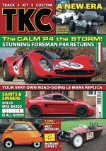D.A.R.T MINI SPECIAL AND THE AMAZING STORY OF DESMOND ‘DIZZY’ ADDICOTT
Desmond Gerald ‘Dizzy Addicott, born in Scotland in 1922, was one of life’s amazing characters and is regarded as one of the UK’s outstanding aviators. He was nicknamed ‘Dismal Desmond’ at school because of his unhappy persona, but he was anything but in later life. STEVE HOLE tells his story.
RAF CAREER AND TEST PILOT
When Desmond joined the RAF in 1941, he was immediately popular with his colleagues but regarded as a bit scatty, hence the amendment of his nickname to ‘Dizzy’. It is said that there was never a dull moment when he was around. The majority of his air training took place in Canada learning on Tiger Moths and Harvards.
He first saw active service near the end of the war in 1945 in Burma flying Mosquitos for 110 Hyderabad Squadron (usually while wearing a ‘medicine hat’) and was part of the advance on Rangoon and Singapore.
In 1946, he was promoted to Squadron Leader and joined 84 Squadron in Java. Late that year he joined 13 OTU operational training unit at RAF Harwell in Oxfordshire as an instructor on Mosquito 1s and Mosquito IIs.
He did that until late 1947, when he was on the move again to 201 AFS (Advanced Flying School) at RAF Swinderby, instructing on various types but usually Wellington T10s.
In 1949, Dizzy left the RAF but continued his flying career and between 1950-51 he was a civilian instructor training Royal Navy pilots to fly his beloved Mosquitos, while at the same time was a civilian working for No.3 Civilian Anti-Aircraft Cooperation Unit part of the Auxiliary Reserve Force.
This unit had fifteen aircraft and 200 volunteer pilots, Dizzy being one of them, who flew Spitfires, Beaufighters, Vampires (as the aggressors) and Hawker Henley TTs, which had a 30ft red flag towed behind it as the ‘target’. Addicott had lots of hilarious stories about this period of his career.
He joined Short Brothers and Harland in 1951 as a civilian ferry pilot for the Royal Naval Air Service, which is when he first got the chance to sample flying boats like the Sunderland and Catalina. In 1955, he went to work for Vickers Armstrong at Wisley, Surrey, as a test pilot specialising in Comms and Production duties on Rapides, Doves and Herons and he also flew Valetta, Varsity, Viking and Canberra on guided weaponry duties.
Addicott also flew Valiants and was part of the development team for airborne refuelling. In fact, he flew as the tanker pilot on the first V-Bomber to V-Bomber air refuelling flight.
By 1960 Vickers had merged with Hunting Aircraft, Bristol and English Electric to form British Aircraft Corporation (BAC). In 1961, Dizzy was sent on secondment to Hunting Aircraft and served as a senior test pilot on the Jet Provost. It was back to Vickers-Armstrong in 1965 and he was part of the test team on Vanguards, Viscounts, BAC 1-11 and VC-10.
He spent eight years at the old Bristol Aircraft factory (also part of BAC) at Filton from 1971 where he flew air comms duties on HS125, Dakota DC-3, President, Heron and Dove.
Even when his commercial flying career was over Dizzy still took to the air as a show pilot and appeared in several films (see separate boxouts). He had been of the UK’s most famous and revered test pilots alongside the likes of Trevor ‘Wimpy’ Wade, Roland ‘Bee’ Beamont, CBE, DSO & BAR, Bill Humble and Eric ‘Winkle’ Brown.
There were over 300 aircraft types in his logbook by the time his aviation career had ended. Amazing.
AIR SHOW PILOT
Dizzy became one of the UK’s leading air show pilots and was a regular on the circuit, thrilling crowds all over the country with his entertaining demonstrations of classic aircraft. These included a Douglas Dakota C-47, Hunting H-126 and many others.
Addicott also flew (shared with Bob Hoare) a beautiful Vimy replica, built at Brooklands by the Vintage Aircraft Flying Association (registered G-AWAU) that made its maiden flight in 1989 at the Biggin Hill Airshow. It later caught fire and was badly damaged. Subsequently restored it is now on display at the RAF Museum at Hendon.
In 1995, when pop star and aircraft fanatic, Gary Numan was heavily in flying, Dizzy taught him to fly a Harvard and the pair were described as an odd couple during that summer, but they got on very well.
FUNNY STORIES
Dizzy was described as a spellbinding storyteller with outspoken opinions on most things as well as a love for fine French wine. A couple of stories that I picked up on that are extremely memorable and amusing include:
While at BAC, Dizzy was sent to New York’s JFK airport to collect a malfunctioning Vickers VC-10 (it may have been a BOAC aircraft) and return it to the UK for repair. The flight contained air crew seated in first class for the flight home and cabin crew (hostesses) sat in the back of the aircraft.
Halfway across the Atlantic, it’s said that Dizzy fancied a bit of fun and decided to barrel-roll the VC-10. The only trouble was although he’d given the aircrew a bit of notice that he was going to do it he hadn’t told the cabin crew who didn’t much like being thrown around in such a way.
Another funny one was when he was doing a display at Coventry Airport in one of his regulars, a Dakota C-47. According to reports, an over-enthusiastic chap in charge of pyrotechnics had arranged for the runway to be lined which incendiaries that were to be set off at a designated moment to give the effect of a wartime runway being strafed and bombed by the Luftwaffe.
I’m not sure exactly how but as Dizzy came round for a low pass of the runway in his rumbling and labouring old Dakota the incendiaries went off unexpectedly and nearly blew him out of the sky. Only his skill and quick thinking avoided a nasty accident. It’s sad that when Addicott landed, he was in a rage and immediately sought out the hapless props man chasing him around the Ops Rooms with a barrage of expletives and also saying something along the lines of that he’d never had such a hair-raising experience when flying Mosquitos in the RAF during the war!
FILM WORK
Along with his airshow work, Dizzy Addicott appeared as an extra in many aviation-flavoured films. If there was a second war film depicting the RAF, he was almost certainly filmed flying at least one aircraft in it. His credits included:
Aces High (1976)
Biggles (1986)
Biggles: Adventures in Time (1988)
The Great Egg Race (1979)
The Dirty Dozen (1967 – Flying a Junkers JU-52)
Mosquito Squadron (1969)
The Blue Max (1966)
Memphis Belle (1990)
The Great Atlantic Air Race (2003 Canadian TV documentary as himself)
MOTORSPORT
Dizzy Addicott was described as a very accomplished racing driver and drove – albeit as a gentleman driver – at a high level. He’d started racing on motorbikes. In 1960-61 he was even a works driver for Elva Cars’ Formula Junior team in an Elva-DKW.
During his career, he regularly raced against some top drivers including Jimmy Blumer, Hugh Dibley, Mike Parkes and Frank Gardner.
He liked a Lotus and at various times competed in a Seven, Eleven and Fifteen with decent levels of success. One day at a Brands Hatch Wednesday test day he broke the lap record in his Lotus Eleven with a 1220cc engine at 1:35 dead but the clerk of the course refused to acknowledge it as it beat Jean Behra’s official record set in his Porsche RSK Spyder and he didn’t think that Dizzy, in his little Lotus, could possibly have beaten it.
Other makes he raced included Arnott (Climax Sports) and of course, a Mini or three. Unfortunately, somewhere along the line, Dizzy picked up an illness called sleeping sickness, which would often catch him out. One day at Brands Hatch in 1962 he was fast asleep on the grid before a race.
Away from Elva, he entered as a privateer under the D.A.R.T banner which stood for Dizzy Addicott Race Team.
AUTOMOTIVE FUN AND A D.A.R.T!
One of Dizzy’s first ‘specials’ was an old Mini Van that he had well-known metal bashers Wakefield’s of Byfleet create him a streamlined aluminium body. They were also involved again with the D.A.R.T project and Addicott had them produce eight bodyshells.
He was friends with many people from motorsport both drivers and engineers alike. One of his best mates was Paul Emery (Hillman Imp tuner, car designer and GP entrant under the Emeryson banner) who had a lot of input on what became known as the D.A.R.T. He definitely supplied Dizzy with a tasty Mini Cooper engine for it.
Addicott’s many aviation contacts came in handy as he pulled in a favour from one which allowed him to put his car in a wind tunnel for pre-launch testing.
Sufficiently pleased with the result Dizzy decided to display the car at the Racing Car Show in January 1964 at the Royal Horticultural Halls, Westminster. The car was very well received and Jem Marsh of Marcos was extremely impressed and wanted to put it into production but with a GRP monocoque.
Unfortunately, the two fell out and parted on extremely bad terms (I don’t think they ever spoke again). Marsh would devise his own version of the Mini-based car, calling it the Mini-Marcos, while Dizzy, who had kept four of the Wakefield-built ‘shells looked around for someone else to work with on the D.A.R.T. All no avail though and he became so disillusioned he sold the prototype and project to Jeremy Delmar-Morgan for £750 (a lot of money back then and the equivalent to £10,600 today, allowing for inflation), a deal brokered by Paul Emery, incidentally. Delmar-Morgan, nicknamed ‘Jem’, put it into production as the Mini-Jem.
Talking of Paul Emery. He marketed a one-piece replacement rear door for a Mini Clubman van that had been designed by Dizzy Addicott.
Dizzy also had an idea for a Mini-based three-wheeler and also a tiny speed record car based on a Bond Minicar that had a 250cc Lombardini engine. Both were stillborn as was the Bentley Mk6 Special idea he had.
He was said to be a very generous man. One afternoon, always in a hurry and late for something or other he turned up at a friend’s house with a Mini 850 on a trailer, with a load of spares. He proceeded to give the car and the trailer and spares to the man as a gift.
He was a regular visitor to Emery’s workshop in West London, where he was a popular figure, although they called him the ‘lucky nutter’, after the various ideas he had and various scrapes he got into.
One, in particular, was pretty hair-raising. While out in his Mini Cooper S, one day he lost control, and left the road, crashing through two garden fences and a greenhouse before coming to a halt buried in someone’s patio doors. He was lucky to walk away unscathed.
There is also another story of a large storage unit he had near Newhaven, East Sussex that was full of his sizeable car collection be they racing cars or interesting road vehicles. It was here that he invented a streamlined roof-box device that didn’t go into production but should have done (ahead of its time) and also a terrifying-sounding garage heater that was fuelled by diesel, which was sparked by an injector. It was said to have glowed cherry red when switched on.
Dizzy was also very serious about having a crack at Craig Breedlove’s land speed record, which, at the time, stood at 407mph. Plans were quite advanced although nothing came of it in the end.
RACONTEUR AND AFTER-DINNER SPEAKER
I never met Dizzy Addicott but I wish I had. Whenever I got the chance, I always spoke to wartime aviators and test pilots and I had the privilege to meet a few. All were stout-backed, who stood ramrod straight and even in their eighties had iron handshakes. One of my personal highlights was spent in the bar of a hotel in Lincolnshire and an hour’s chat with the late Johnny Johnson, the bomb aimer who flew on Lancasters in 617 Squadron and took part in the Dambusters raid.
Even at 100 years old he was lucid, had a glint in his eye and captivated me with the way he recalled his part in history. He was also very gracious. I imagine Dizzy was similar in character.
The way he was talked of by fellow flyers was notable not only for his skill in the air but for his sense of humour and ability to tell a great story. From what I have read, if you were at a dinner where he was booked to give a talk you were in for a treat.
I note that many of the obituaries and aviation forums where Dizzy’s death was announced described Dizzy as having ‘great hands’, which in WW2 parlance is said to have saved many pilots’ lives (and their crew) who got into scrapes.
In 1999, Dizzy had a Teflon-Felt supported aorta fitted. Sadly, it was a burst aorta (aka brain aneurism) that tragically killed him while driving on the M11 motorway near Stansted on December 10, 2005. He was on his way to an evening function.
Rather ironic that a man who had survived so many scrapes and seen and done so much in his 83 years went out in such a way. He was buried in a cemetery near his home in Burnham-on-Sea, Somerset.
The forums I read about Dizzy were full of stories of ex-colleagues all expressing a deep fondness for him, many with hilarious tales, some alluding to stories they couldn’t tell, while all waxed lyrically about his pilot skill.
He was also described as a proper gentleman. Dizzy’s wife Judy died in 2010.
| Print article | This entry was posted by admin on May 11, 2023 at 3:31 pm, and is filed under Uncategorized. Follow any responses to this post through RSS 2.0. Both comments and pings are currently closed. |
Comments are closed.















